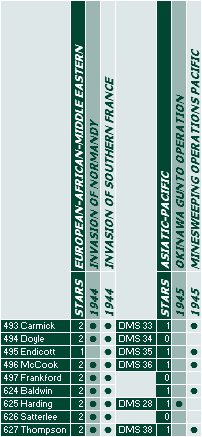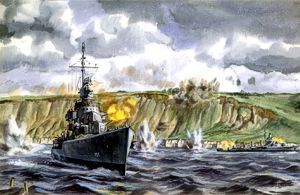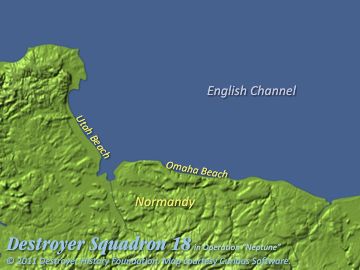
World War II operations of
destroyers originally
attached to Squadron 18

These nine destroyers joined the Atlantic Fleet. From 1943 when they individually “fleeted in” through early 1944, they were assigned to duty as convoy escorts and task force screens.

Emmons and Doyle (right) at Omaha Beach on D-Day in Targets of Opportunity by Dwight Shepler.
In June 1944, the squadron—with Emmons substituting for Endicott, which had been damaged in a collision—formed Fire Support Group “O,” closing Omaha Beach on D-day until “they had their bows against the bottom” to deliver callfire support.
Moving to the Mediterranean Sea for the invasion of southern France in August, the squadron was attached to Task Group 80.6, an Antisubmarine and Convoy Control Group, with British and French destroyers.

DesRon 18 at Normandy, June 1944.
In October, Harding began conversion as a fast minesweeper and was attached to Mine Squadron 20. In 1945, Carmick, Doyle, Endicott, McCook and Thompson were also converted as fast minesweepers and attached to Mine Squadron 21. These six minesweepers went to the Pacific—Harding in time to operate at Okinawa, where she was damaged beyond economical repair, and the others in time to participate in end-of-war minesweeping operations.
Baldwin, Frankford and Satterlee also went to the Pacific. Satterlee, attached to DesDiv 12, arrived in May 1945 and commenced air-sea rescue patrol duty between Saipan and Okinawa. The others arrived in August and supported post-war minesweeping operations, for which Baldwin earned one service star along the Chinese and Korean coasts.
Source: Destroyer History Foundation database and Dictionary of American Naval Fighting Ships entries for individual ships, Morison.